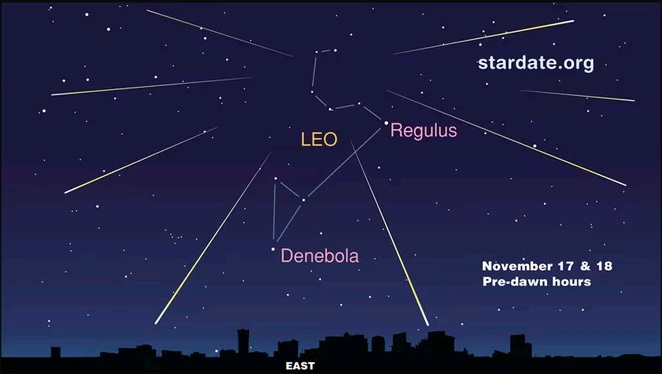
This month the annual Leonid meteor shower returns once again to fill the night sky with ‘shooting stars’. This shower has become somewhat famous thanks to having a history of producing intense meteor storms with rates of up to 50,000 meteors per hour. These kind of rates will not happen this year unfortunately. Rates are expected to reach around 10 to 20 meteors per hour at its peak on the night of 17th November.
The meteors are remnants of Comet Tempel-Tuttle. The Earth passes through the orbital plane of the comet every November causing tiny pieces of rock and dust left over from the comet to enter the Earth’s atmosphere.
Observing opportunities
This year, the full Moon will be out of the way (new Moon occurs on the 18th) so viewing conditions should be excellent (weather permitting) without any moonlight potentially washing out the fainter meteors from view. The Leonid meteors begin their streak across the sky from the constellation of Leo as shown in the illustration above, however please read on to find out the best way to observe the light show. This is not the place in the sky to look!
The best time to view the Leonids
The constellation of Leo doesn’t rise until after midnight so this would be the best time to get outside looking as rates should be at the highest during the early hours on the night of 17-18 November.
How to observe the Leonids
As the meteors are visible to the naked eye, no special equipment is needed other than your eyes! A common mistake is to find the direction of the constellation of Leo and concentrate on that area of the sky. This is not the best way to observe them. The meteors start there journey from here but then streak across a large part of the sky so you are actually more likely to catch them in other parts of the sky as they suddenly brighten. The best method is to get a reclining chair and lie down flat so you can see as much of the sky as possible. Keep plenty of layers on and wear a hat. November nights in the early hours can get bitterly cold, especially when not moving around much!

Leave a Reply